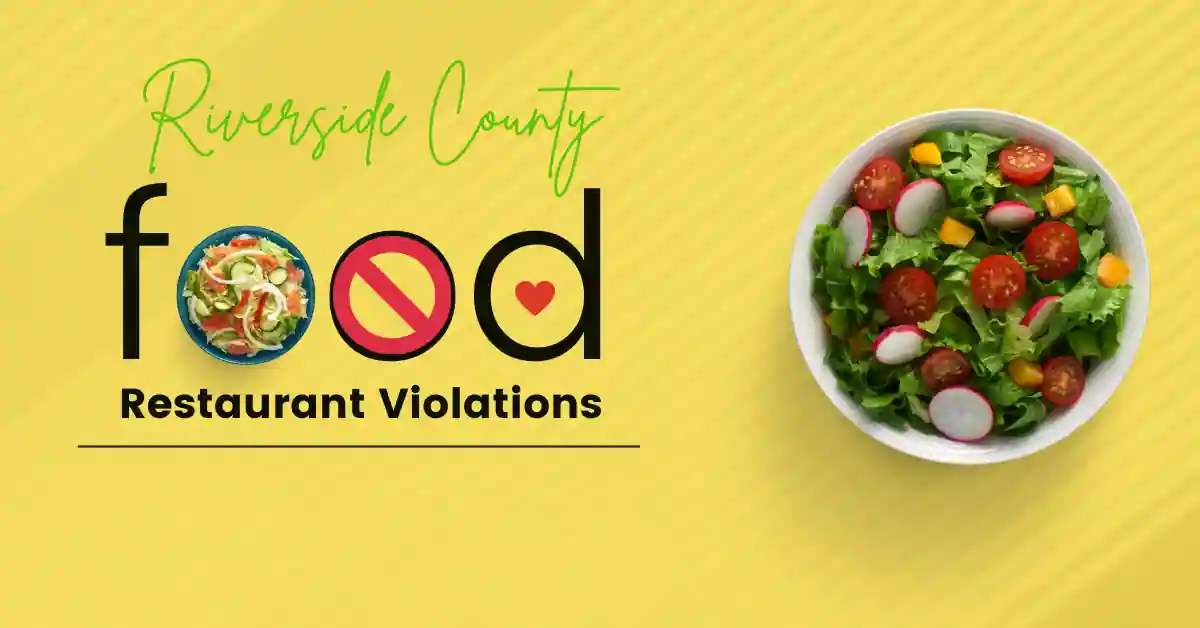Have you ever sat down at a restaurant, ordered your meal, and wondered what’s going on in the kitchen? Sure, the food looks great when it’s placed in front of you, but what about the cleanliness and safety behind the scenes?
In Riverside County, food restaurant violations are a big concern, just like in other places. These violations can affect your health and your dining experience. Today, we will look at some common restaurant violations, their effects, and how restaurants can prevent them.
Table of Contents
ToggleUnderstanding Restaurant Health Inspections
Before we get into the details of violations, let’s understand what health inspections are and why they are important.
What Is the Purpose of Health Inspections?
Restaurant health inspections are done to keep you safe. That is the main goal.
Inspectors look for things that can cause foodborne illnesses. This includes bad food storage and dirty kitchen habits. Their job is to ensure the food you eat is safe, no exceptions.
Who Conducts These Inspections?
In Riverside County, the Department of Environmental Health sends out trained health inspectors to conduct these inspections. They usually show up unannounced, which keeps restaurants on their toes. After all, if they knew when the inspector was coming, they might only clean up the kitchen for that one day!
Common Riverside County Food Restaurant Violations
Even with these inspections in place, violations still happen. Some are minor, while others can be quite alarming.
Food Storage and Temperature Violations
One common problem inspectors find is with food storage and temperature control. Perishable food must be kept at the right temperatures. This helps keep it safe from harmful bacteria.
Importance of Proper Food Storage
Cold foods need to be kept at 41°F or lower, while hot foods should be kept at 135°F or higher. Not keeping these temperatures can allow bacteria like salmonella or E. coli to grow. This can make diners very sick. It might seem like a small detail, but it’s crucial.
Cross-Contamination Issues
Cross-contamination is another big issue. This occurs when hazardous germs or allergies spread from one food item to another.
How Cross-Contamination Happens
Imagine raw chicken being prepped on a cutting board, and then, without cleaning it, the same board is used to chop vegetables. That’s how cross-contamination happens, and it’s a fast track to food poisoning. Even worse, for people with allergies, this can be deadly.
Sanitation and Cleanliness Violations
No one wants to think about it, but sometimes restaurant kitchens aren’t as clean as they should be.
Lack of Handwashing
Surprisingly, one of the most frequent violations is a simple one: handwashing. Employees not washing their hands after handling raw foods or using the restroom is a big no-no, but it happens more often than you’d think. And it doesn’t take much imagination to see how quickly that can turn into a health hazard.
Pest Control and Hygiene Violations
Ever see a cockroach scurrying across a restaurant floor? It’s enough to make you lose your appetite. Pest control violations are serious and can lead to immediate closures if left unresolved.
The Consequences of Health Violations
Health violations aren’t just about getting a slap on the wrist. The consequences can be severe for restaurants that don’t follow the rules.
Fines and Legal Action
Depending on the severity of the violation, restaurants can be hit with hefty fines. If the issues persist, they could even face legal action, which might lead to temporary or permanent closures.
Public Health Concerns
The biggest concern, of course, is the risk to public health. Foodborne illnesses can send people to the hospital, and in extreme cases, they can be life-threatening. That’s why these regulations exist in the first place—to keep you safe.
How Restaurants Can Avoid Violations
So, how can restaurants avoid falling into the violation trap? It’s not rocket science, but it does require consistent effort.
Proper Staff Training
Ensuring that all employees are trained in food safety practices is key. Training is the first line of defense against violations. It includes washing hands properly and storing food at the right temperatures.
Regular Maintenance and Monitoring
Regularly maintaining kitchen equipment and monitoring food safety practices can prevent small issues from snowballing into bigger problems. A little attention to detail goes a long way.
The Role of Consumers in Reporting Violations
Did you know that diners play a role in keeping restaurants accountable too?
How to Report a Violation
If you see something wrong during your meal, like a dirty dining area or bad food handling, you can report it. Contact the Riverside County Department of Environmental Health. Your report could lead to an inspection that might prevent others from getting sick.
The Importance of Transparency in Health Inspection Scores
When you see a restaurant’s health score posted, that grade is more than just a formality. It’s a reflection of their commitment to food safety.
What Does an “A” Grade Mean?
“A” grade means the restaurant passed its health inspection with minimal violations. It’s a sign that the restaurant is maintaining high standards of cleanliness and food safety.
What Happens to Restaurants with Low Scores?
Health inspectors usually give restaurants with lower scores a chance to fix the violations. If they do not make the needed improvements, health officials may close them until the problems are fixed.
Conclusion
Riverside County food restaurant violations are a serious matter. While most restaurants work hard to follow the rules, violations can still happen. By staying informed and knowing what to look out for, both restaurant owners and diners can play a role in making sure food is safe. So, the next time you dine out, remember: it’s not just about how good the food tastes—it’s also about how safe it is.
FAQs
What Are the Most Common Violations?
The most common violations include improper food storage, cross-contamination, lack of cleanliness, and pest control issues.
How Often Are Inspections Conducted?
Health inspections in Riverside County usually happen once or twice a year. This depends on the type of restaurant and its compliance history.
What Should I Do If I See a Violation?
If you notice a health violation at a restaurant, you can report it. Contact the Riverside County Department of Environmental Health to make your report. Your report could lead to a formal inspection.
Can a Restaurant Recover from a Low Health Score?
Yes, a restaurant can recover by addressing the violations and passing a re-inspection. However, repeated low scores can lead to permanent closure.
Are inspection reports publicly available?
Yes, health inspection reports are available to the public. You can check them online through Riverside County’s official website to see how your favorite restaurants are doing.






